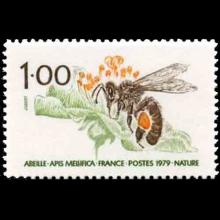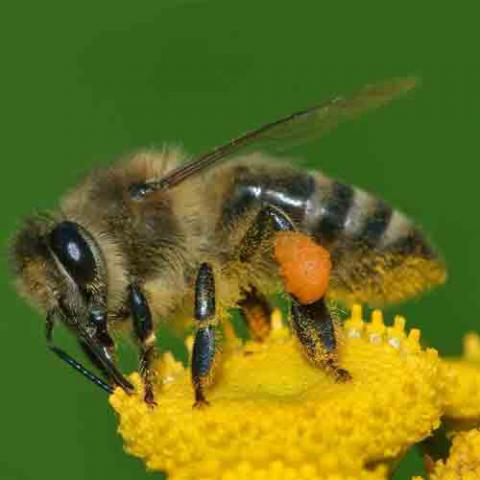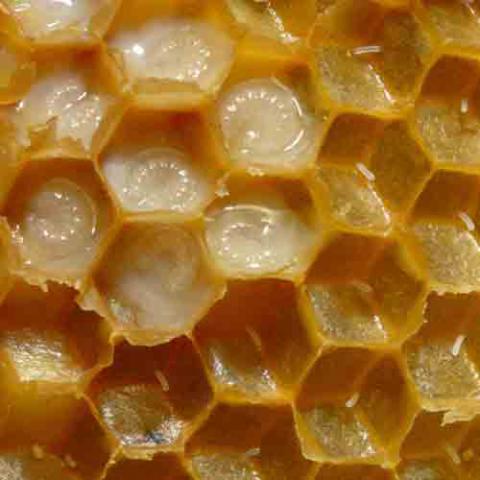NAMES
TAXONOMY
Israel
Issued:
Stamp:
Apis mellifera
France
Issued:
Stamp:
Apis mellifera
Israel
Issued:
Stamp:
Apis mellifera
France
Issued:
Stamp:
Apis mellifera
Israel
Issued:
Stamp:
Apis mellifera
France
Issued:
Stamp:
Apis mellifera
A Honeybee’s Tongue Is More Swiss Army Knife Than Ladle
Once again, insects prove to be more complicated than scientists thought they were. For a century, scientists have known how honeybees drink nectar. They lap it up. They don’t lap like cats or dogs, videos of whose mesmerizing drinking habits have been one of the great rewards of high speed video. But they do dip their hairy tongues rapidly in and out of syrupy nectar to draw it up into their mouth. For the last century or so, scientists have been convinced that this is the only way they drink nectar. Scientists have now discovered bees can also suck nectar, which is more efficient when the sugar content is lower and the nectar is less viscous. High-speed video of bees drinking a nectar substitute in a lab shows that not only do honeybees have this unexpected ability, they can go back and forth from one drinking mode to another.
Jianing Wu, an engineering and biophysics specialist, at Sun Yat-sen University in Guangzhou, China, and the senior researcher on the experiment, said that while honeybees excel at feeding on highly concentrated nectar, “we find that they can also flexibly switch the feeding strategy from lapping to suction.” He and his colleagues reported the results on Wednesday in the journal Biology Letters.
David Hu, a professor at the Georgia Institute of Technology, who supervised some of Dr. Wu’s earlier research but was not involved in this experiment, said: “We thought that insects’ mouths were like tools in your kitchen drawer (straw, fork, spoon), e.g., with single uses. Wu showed that honeybee tongues are like a Swiss army knife, able to efficiently drink many type of nectar,” Dr. Hu said.
Alejandro Rico-Guevara, who runs the Behavioral Ecophysics Lab at the University of Washington, Seattle and studies nectar feeding in birds, also worked on the project. He said this flexibility in nectar drinking behavior means that although bees prefer the more syrupy nectars, they can efficiently feed from flowers whose nectar is more watery. “This has implications at many different scales, from pollination, for our food, all the way to the role they have in natural ecosystems,” he said. What Dr. Rico-Guevara found most interesting was that the bees are so sensitive to the viscosity of the nectar that “they switch at the exact point you would expect, to get the best reward for the energy invested.”
The honeybee tongue is adapted perfectly to lapping syrupy nectars. Once the tongue is dipped into thick nectars, Dr. Wu explained, “approximately 10,000 bristles covering the tongue erect simultaneously at a certain angle for trapping the nectar.” The bee then pulls its tongue back into its proboscis, which is really a part of its mouth, and a pumping mechanism in the head sucks the nectar off the tongue. When the viscosity changes so that the nectar is less thick, the bees let their tongues stay in the nectar and sucked it up into their mouths, apparently using the same pumping mechanism. Dr. Hu said, “The result makes perfect sense because honeybees are already known as generalists.” They are not limited to feeding on only one type of flower like some other species of bee.
The bees have been flexible all along. It was the scientists who were stuck on one idea.
Genus species (Animalia): Apis mellifera
The western honey bee can be found on every continent except Antarctica. The species is believed to have originated in Africa or Asia, from where it spread throughout Africa, the Middle East and Europe. Humans are responsible for its considerable additional range, introducing European subspecies into North America (early 1600s), South America, Australia, New Zealand, and East Asia.
Western honey bees adapted to the local environments as they spread geographically. These adaptations include synchronizing colony cycles to the timing of local flower resources, forming a winter cluster in colder climates, migratory swarming in Africa, and enhanced foraging behavior in desert areas. All together, these variations resulted in 28 recognized subspecies, all of which are cross-fertile. The subspecies are divided into four major branches, based on work by Ruttner and confirmed by mitochondrial DNA analysis. African subspecies belong to branch A, northwestern European subspecies branch M, southwestern European subspecies branch C and Middle-Eastern subspecies branch O.
Unlike most other bee species, honey bees have perennial colonies which persist year after year. Because of this high degree of sociality and permanence, honey bee colonies can be considered superorganisms, meaning that reproduction of the colony, rather than individual bees, is the biologically significant unit. Honey bee colonies reproduce through a process called "swarming".
In most climates, western honey bees swarm in the spring and early summer, when there is an abundance of blooming flowers from which to collect nectar and pollen. In response to these favorable conditions, the hive creates one to two dozen new queens. Just as the pupal stages of these "daughter queens" are nearly complete, the old queen and approximately two-thirds of the adult workers leave the colony in a swarm, traveling some distance to find a new location suitable for building a hive (e.g., a hollow tree trunk). In the old colony, the daughter queens often start "piping", just prior to emerging as adults, and, when the daughter queens eventually emerge, they fight each other until only one remains; the survivor then become the new queen. If one of the sisters emerges before the others, she may kill her siblings while they are still pupae, before they have a chance to emerge as adults.
Once she has dispatched her rivals, the new queen, the only fertile female, lays all the eggs for the old colony, which her mother has left. Virgin females are able to lay eggs, which develop into males (a trait shared with wasps, bees, and ants because of haplodiploidy). However, she requires a mate to produce female offspring, which comprise 90% or more of bees in the colony at any given time. Thus, the new queen goes on one or more nuptial flights, each time mating with 1–17 drones. Once she has finished mating, usually within two weeks of emerging, she remains in the hive, laying eggs.
Throughout the rest of the growing season, the colony produces many workers, who gather pollen and nectar to prepare for winter; the average population of a healthy hive in midsummer may be as high as 40,000 to 80,000 bees. Nectar from flowers is processed by worker bees, who evaporate it until the moisture content is low enough to discourage mold, transforming it into honey, which can then be capped over with wax and stored almost indefinitely. In the temperate climates to which western honey bees are adapted, the bees gather in their hive to wait out the winter, during which the queen may stop laying. During this time, activity is slow, and the colony consumes its stores of honey for energy to stay warm. In mid- to late winter, the queen starts laying again in preparation for spring (this is probably triggered by day length). Depending on the subspecies, new queens (and thus swarms) may be produced every year, or less frequently, depending on local environmental conditions.
Like other insects that undergo complete metamorphosis, the western honey bee has four distinct life stages: egg, larva, pupa and adult. The complex social structure of honey bee hives means that all of these life stages occur simultaneously throughout much of the year. The queen deposits a single egg into each cell prepared by worker bees. The egg hatches into a legless, eyeless larva fed by "nurse" bees (worker bees who maintain the interior of the colony). After about a week, the larva is sealed in its cell by the nurse bees and begins its pupal stage. After another week, it emerges as an adult bee. It is common for defined regions of the comb to be filled with young bees (also called "brood"), while others are filled with pollen and honey stores.
Worker bees secrete the wax used to build the hive, clean, maintain and guard it, raise the young and forage for nectar and pollen, and the nature of the worker's role varies with age. For the first ten days of their lives, worker bees clean the hive and feed the larvae. After this, they begin building comb cells. On days 16 through 20, workers receive nectar and pollen from older workers and store it. After the 20th day, a worker leaves the hive and spends the remainder of its life as a forager. Although worker bees are usually infertile females, when some subspecies are stressed they may lay fertile eggs. Since workers are not fully sexually developed, they do not mate with drones and thus can only produce haploid (male) offspring.
Queens and workers have a modified ovipositor, a stinger, with which they defend the hive. Unlike bees of any other genus and the queens of their own species the stinger of worker honey bees is barbed. Contrary to popular belief, a bee does not always die soon after stinging; this misconception is based on the fact that a bee will usually die after stinging a human or other mammal. The stinger and its venom sac, with musculature and a ganglion allowing them to continue delivering venom after they are detached, are designed to pull free of the body when they lodge. This apparatus (including barbs on the stinger) is thought to have evolved in response to predation by vertebrates, since the barbs do not function (and the stinger apparatus does not detach) unless the stinger is embedded in elastic material. The barbs do not always "catch", so a bee may occasionally pull its stinger free and fly off unharmed (or sting again).
Although the average lifespan of a queen in most subspecies is three to five years, reports from the German-European black bee subspecies previously used for beekeeping indicate that a queen can live up to eight years. Because a queen's store of sperm is depleted near the end of her life, she begins laying more unfertilized eggs; for this reason, beekeepers often replace queens every year or two.
The lifespan of workers varies considerably over the year in regions with long winters. Workers born in spring and summer will work hard, living only a few weeks, but those born in autumn will remain inside for several months as the colony clusters. On average during the year, about one percent of a colony's worker bees die naturally per day. Except for the queen, all of a colony's workers are replaced about every four months.
Queen bee
The queen bee is a fertile female, who, unlike workers (which are genetically also female), has a fully developed reproductive tract. She is larger than her workers, and has a characteristic rounder, longer abdomen. A female egg can become either a queen or a worker bee. Workers and queens are both fed royal jelly, which is high in protein and low in flavanoids, during the first three days of their larval stage. Workers are then switched to a diet of mixed pollen and nectar (often called "bee bread"), while queens will continue to receive royal jelly. In the absence of flavanoids and the presence of a high-protein diet, queen bees develop a healthy reproductive tract—a task necessary for maintaining a colony of tens of thousands of daughter-workers.
Periodically, the colony determines that a new queen is needed. There are three general causes:
- The hive is filled with honey, leaving little room for new eggs. This will trigger a swarm, where the old queen will take about half the worker bees to found a new colony and leave the new queen with the other half of the workers to continue the old one.
- The old queen begins to fail, which is thought to be demonstrated by a decrease in queen pheromones throughout the hive. This is known as supersedure, and at the end of the supersedure the old queen is generally killed.
- The old queen dies suddenly, a situation known as emergency supersedure. The worker bees find several eggs (or larvae) of the appropriate age range and attempt to develop them into queens. Emergency supersedure can generally be recognized because new queen cells are built out from comb cells, instead of hanging from the bottom of a frame.
Regardless of the trigger, workers develop the larvae into queens by continuing to feed them royal jelly.
Queens are not raised in the typical horizontal brood cells of the honeycomb. A queen cell is larger and oriented vertically. If workers sense that an old queen is weakening, they produce emergency cells (known as supersedure cells) made from cells with eggs or young larvae and which protrude from the comb. When the queen finishes her larval feeding and pupates, she moves into a head-downward position and later chews her way out of the cell. At pupation, workers cap (seal) the cell. The queen asserts control over the worker bees by releasing a complex suite of pheromones known as queen scent.
After several days of orientation in and around the hive, the young queen flies to a drone congregation point – a site near a clearing and generally about 30 feet (9.1 m) above the ground – where drones from different hives congregate. They detect the presence of a queen in their congregation area by her smell, find her by sight and mate with her in midair; drones can be induced to mate with "dummy" queens with the queen pheromone. A queen will mate multiple times, and may leave to mate several days in a row (weather permitting) until her spermatheca is full.
The queen lays all the eggs in a healthy colony. The number and pace of egg-laying is controlled by weather, resource availability and specific racial characteristics. Queens generally begin to slow egg-laying in the early fall, and may stop during the winter. Egg-laying generally resumes in late winter when the days lengthen, peaking in the spring. At the height of the season, the queen may lay over 2,500 eggs per day (more than her body mass).
She fertilizes each egg (with stored sperm from the spermatheca) as it is laid in a worker-sized cell. Eggs laid in drone-sized (larger) cells are left unfertilized; these unfertilized eggs, with half as many genes as queen or worker eggs, develop into drones.
Workers
Workers are sterile females produced by the queen that develop from fertilized, diploid eggs. Workers are essential for social structure and proper colony functioning. They carry out the main tasks of the colony, because the queen is occupied with only reproducing. These females will raise their sister workers and future queens that eventually leave the nest to start their own colony. They also forage and return to the nest with nectar and pollen to feed the young.
Drones
Drones are the colony's male bees. Since they do not have ovipositors, they do not have stingers. Drone honey bees do not forage for nectar or pollen. The primary purpose of a drone is to fertilize a new queen. Many drones will mate with a given queen in flight; each will die immediately after mating, since the process of insemination requires a lethally convulsive effort. Drone honey bees are haploid (single, unpaired chromosomes) in their genetic structure, and are descended only from their mother (the queen). In temperate regions drones are generally expelled from the hive before winter, dying of cold and starvation since they cannot forage, produce honey or care for themselves. There has been research into the role A. mellifera drones play in thermoregulation within the hive. Given their larger size (1.5x), drones may play a significant role. Drones are typically located near the center of hive clusters for unclear reasons. It is postulated that it is to maintain sperm viability, which drops off at cooler temperatures. Another possible explanation is that a more central location allows drones to contribute to warmth, since at temperatures below 25 °C their ability to contribute declines.
Worker policing
When a fertile female worker produces drones, a conflict arises between her interests and those of the queen. The worker shares half her genes with the drone and one-quarter with her brothers, favoring her offspring over those of the queen. The queen shares half her genes with her sons and one-quarter with the sons of fertile female workers. This pits the worker against the queen and other workers, who try to maximize their reproductive fitness by rearing the offspring most related to them. This relationship leads to a phenomenon known as "worker policing". In these rare situations, other worker bees in the hive who are genetically more related to the queen's sons than those of the fertile workers will patrol the hive and remove worker-laid eggs. Another form of worker-based policing is aggression toward fertile females. Some studies have suggested a queen pheromone which may help workers distinguish worker- and queen-laid eggs, but others indicate egg viability as the key factor in eliciting the behavior. Worker policing is an example of forced altruism, where the benefits of worker reproduction are minimized and that of rearing the queen's offspring maximized.
In very rare instances workers subvert the policing mechanisms of the hive, laying eggs which are removed at a lower rate by other workers; this is known as anarchic syndrome. Anarchic workers can activate their ovaries at a higher rate and contribute a greater proportion of males to the hive. Although an increase in the number of drones would decrease the overall productivity of the hive, the reproductive fitness of the drones' mother would increase. Anarchic syndrome is an example of selection working in opposite directions at the individual and group levels for the stability of the hive.
Under ordinary circumstances the death (or removal) of a queen increases reproduction in workers, and a significant proportion of workers will have active ovaries in the absence of a queen. The workers of the hive produce a last batch of drones before the hive eventually collapses. Although during this period worker policing is usually absent, in certain groups of bees it continues.
According to the strategy of kin selection, worker policing is not favored if a queen does not mate multiple times. Workers would be related by three-quarters of their genes, and the difference in relationship between sons of the queen and those of the other workers would decrease. The benefit of policing is negated, and policing is less favored. Experiments confirming this hypothesis have shown a correlation between higher mating rates and increased rates of worker policing in many species of social hymenoptera.
Reference: Wikipedia





